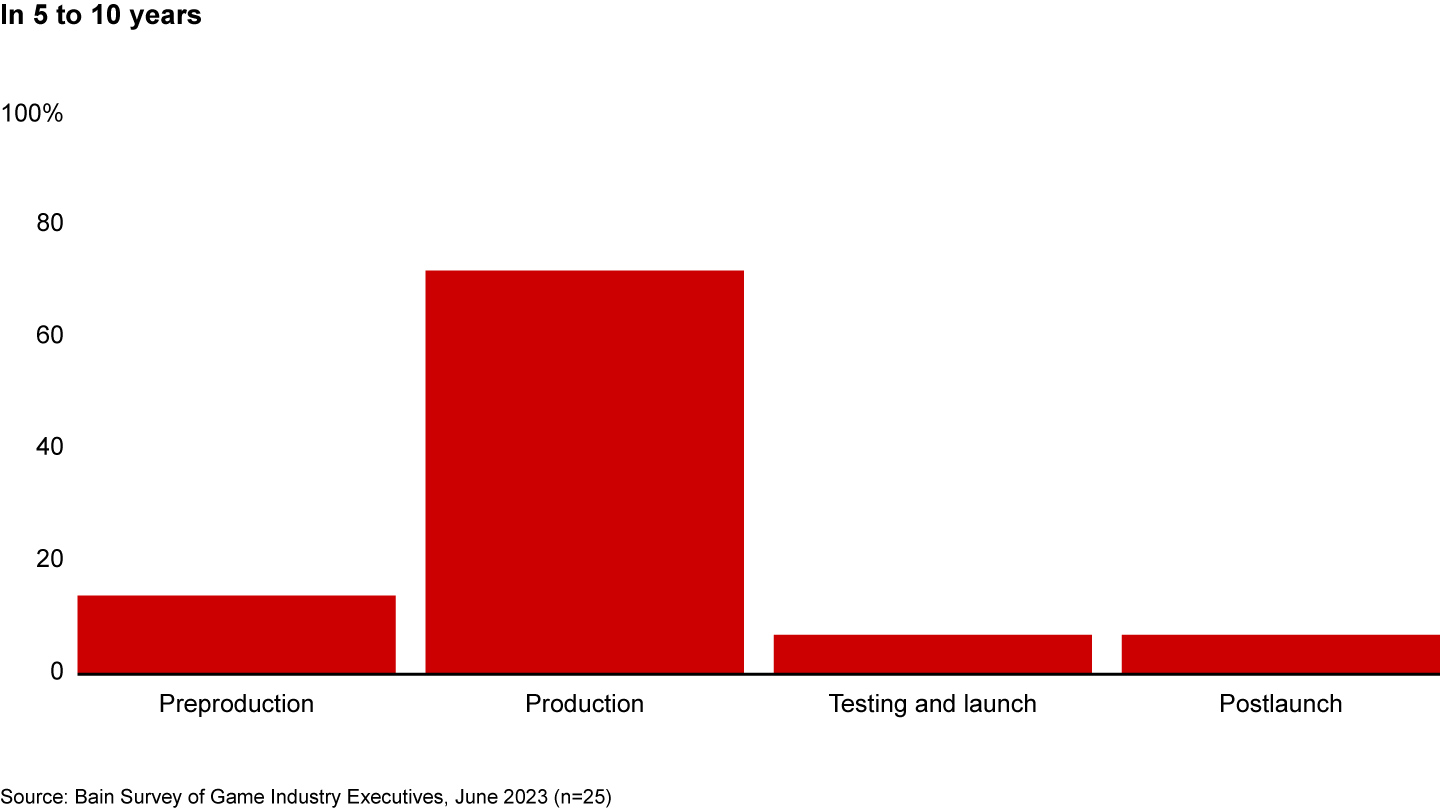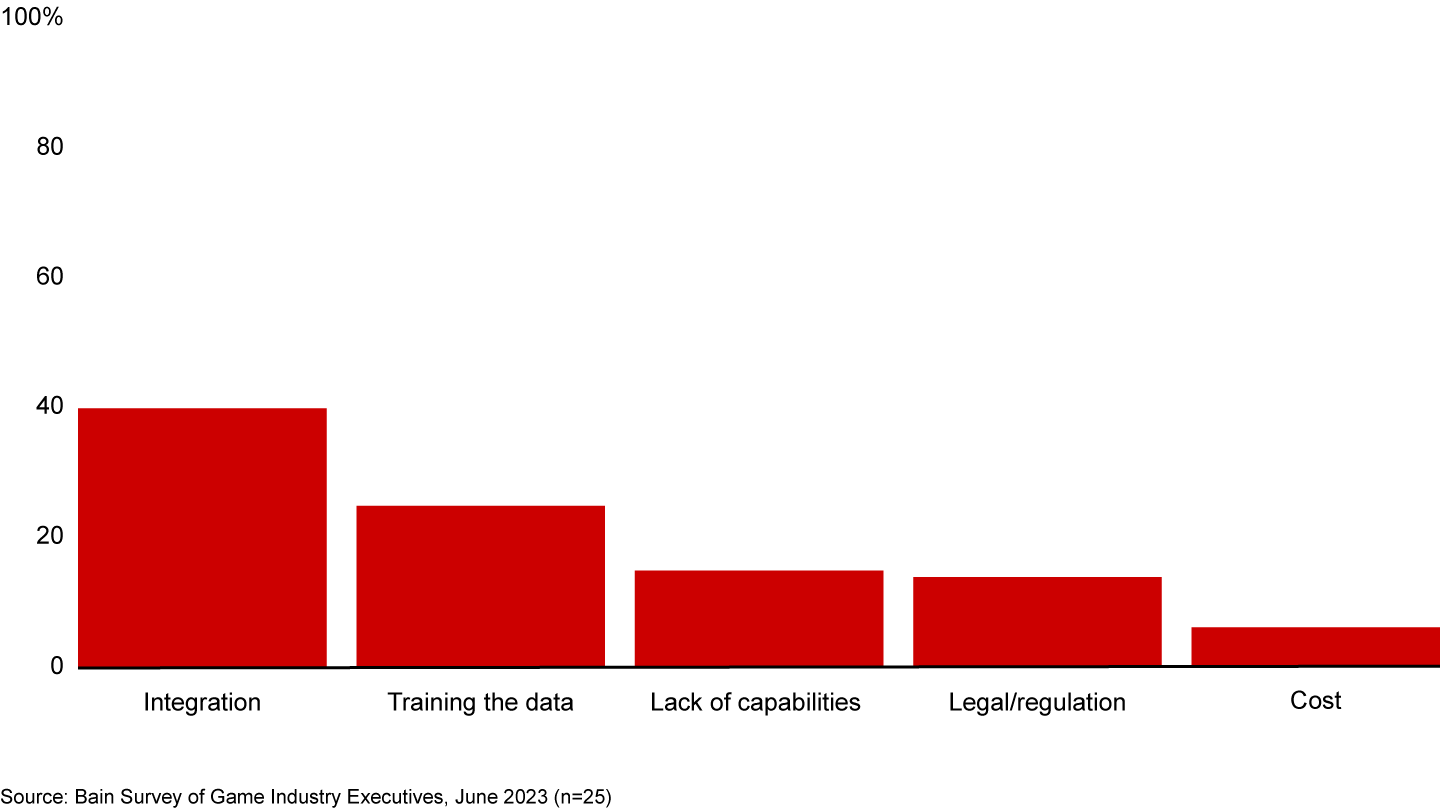Brief

At a Glance
- Video game industry executives believe that within 5 to 10 years, AI could manage more than half of game development.
- Most believe that AI will improve the quality of games and deliver them more quickly; fewer believe that AI will reduce costs.
- AI is already being used in preproduction stages, planning out game content, and industry executives expect that within a few years, it will play a larger role in production, developing characters, dialogue, and environments.
- Few expect AI to solve the industry's talent shortage, and many said that although the technology may free developers from mundane work, it won't replace the creative spark.
Generative AI is just beginning to have an effect on video games, but gaming industry executives believe that over the next 5 to 10 years, it will contribute to more than half of the video game development process.
Bain spoke with gaming industry executives about the potential and the challenges of generative AI for their industry. Most have high expectations for generative AI and the machine learning it’s based on, and they expect it to have a greater effect on their business than other transformative technologies, such as virtual reality or augmented reality and cloud gaming.

Most of these executives see generative AI improving quality and bringing games to market faster. Generative AI will also help make bigger, more immersive, and more personalized experiences a reality. Interestingly, only 20% of executives believe that generative AI will reduce costs, which might be a disappointment to some, given that top-tier games may cost as much as $1 billion to develop. As with any form of automation, there may be concerns about generative AI taking jobs. But most of the executives we spoke with (60%) don’t expect generative AI to have a significant effect on their talent model or alleviate the industry’s critical talent shortage.
Of the four steps in the video game life cycle—namely, preproduction concept development and planning, building the game (production), testing and launch, and ongoing live operations (postlaunch)—executives say they are deploying generative AI mostly in preproduction. For example, Blizzard Entertainment created Blizzard Diffusion, an image generator trained on its own hit titles, including World of Warcraft, to produce concept art for new ideas.
How will the use of generative AI evolve?
Over time, most executives expect generative AI to show more potential in production and later phases, particularly in several key areas (see Figure 1).
- Story generation and nonplayable characters (NPCs): Generative AI could enable limitless interactive stories personalized for each player. NetEase, a Chinese game publisher, has already announced that it will use generative AI to create an NPC chat function in the upcoming mobile version of its massively multiplayer online game Justice Online.
- Game assets: As confidence in the tools grows, generative AI could be used beyond concept art—for example, to fill in or even generate drafts of whole maps.
- Live ops: While executives we spoke with focused mostly on the ability to rapidly generate new in-game assets, such as personalized skins, we see a significant opportunity ahead for generative AI to improve community management and player support.
- User-generated content: Giving players access to generative AI tools could allow them to play a more central role in the story, increasing engagement and inviting players to support the never-ending demand for content.

Challenges to realizing generative AI’s potential
Although many executives expect IP concerns to be resolved within a few years, the complexities around rights and ownership of created content are significant, and the video game industry will likely face the same challenges as the broader media and entertainment industry.
And there are longer-term challenges as well.
- Generative AI strategy: Gaming companies don’t yet have clear, well-developed strategies for making the most of generative AI. That’s common when a new technology arrives. But those that develop a thoughtful ambition and approach will see the earliest success and mitigate potential risks from improper use of the technology. Failing to deploy a disciplined approach to generative AI in the production process could create challenges around prioritization, resource allocation, and integration with existing processes.
- Navigating a complex, nascent generative AI landscape: There are many companies entering this space, from scale leaders to niche players focusing on specific applications. The landscape changes from week to week, no single player offers everything, and it’s not clear yet which company’s products are the best.
- Technology implementation: Executives see technical challenges as a major hurdle, including integrating generative AI into game engines and other development tools, as well as training the model for specific applications, developer styles, and franchises (see Figure 2).
- Talent implications: Generative AI is a contentious subject, and any implementation should be treated with care. Most executives we spoke with agreed that the talent model will benefit by freeing up creatives from labor-intensive tasks, such as coding content for games. Content may be created quicker, but human creativity will remain the source of what makes a video game fun (game design, mechanics). Few expect generative AI to complete tasks all on its own, and many emphasized the importance of human oversight, guidance, and iteration. Only 10% are moderately or extremely concerned about the rise of generative AI. In general, they see generative AI as another tool on the bench of their designers and developers, one that may create new roles and require new training.

What should video game developers do?
Generative AI has risen in prominence so quickly that it caught many off guard. Four key steps can help gaming companies ensure that they’re on solid ground.
- Take a disciplined and proactive approach to generative AI. As the hype around generative AI grows, many companies are jumping in without a clear strategy. Executives taking the time to agree on an ambition and approach alongside appropriate guardrails and governance will improve return on investment and limit risk.
- Base decisions on what will benefit the player. The core goal is still creating fun, engaging games. Generative AI can help in many ways, but overreliance could also make it a hindrance. More content and engagement in a game does not guarantee a better player experience. This was the case earlier this year when developers of Forspoken adjusted the game to reduce the chattiness of main characters after players expressed frustration at the quantity of dialogue.
- Strategically assess building vs. buying vs. partnering opportunities. A huge ecosystem of applications is evolving rapidly, providing a wide range of services. Developer-publishers should carefully assess when to build in-house, when to partner with scale players within the ecosystem, and when to partner with smaller, niche players.
- Recognize this is more than a technological transformation. To achieve generative AI’s full potential, companies will need to stand up a new operating model by redesigning existing work processes, creating new processes, addressing downstream implications (including the impact on talent), and developing AI enterprise architecture strategy.
It’s an exciting time for the video game industry. Games are getting bigger, development costs are ballooning, and it remains as hard as ever to retain top talent. At the same time, players’ expectations are rising, as they’re demanding more immersive experiences and a bigger role in creating those experiences. Now, generative AI enters the game. There’s plenty of hype, but there’s also incredible potential, which, if harnessed properly, can deliver massive benefits to players, creators, and publishers.

